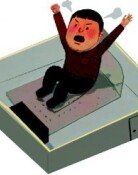30-somethings leading consumption patterns in Korea
30-somethings leading consumption patterns in Korea
Posted January. 28, 2011 16:10,
Kim Young-in, a 37-year-old manager at an established real estate developer, lives with his working wife and their young daughter. Receiving an e-mail about a department store sale, he made a shopping list on his smartphone and left home.
Entering the store, he noticed that his favorite clothing brand Polo was offering a discount of 30 percent. A shirt he saw on a business trip in the U.S. last year was selling for a cheaper price.
After buying it at a sale price of more than 300,000 won (269 U.S. dollars), he brought his wife to a brand-name handbag store. Though she balked at paying more than one million won (897 dollars) for a bag, Kim bought one for her to mark their seventh wedding anniversary next month.
The 397 generation, referring to those who are in their 30s, went to college in the 1990s, and were born in the 1970s, have emerged as key customers.
According to Shinsegae Department Stores sales data for last year compiled by age, those in their 30s comprised the largest purchasing group with purchases of 802.8 billion won (720 million dollars) worth of goods, or 31 percent of combined sales, followed by those in their 40s with 26 percent.
This is the first time that 30-somethings were the top purchasers at the department store and for the share of purchases by an age group to exceed 30 percent. In the past, the share of buying by those in their 40s was the largest.
With the 386 generation, or those who were in their 30s in the 2000s, went to college in the 1980s, and born in the 1960s, now over age 40, the 397 generation has become a key consumer base.
The former generation went to college amid social and political unrest and spent money on necessities but the latter grew up amid economic prosperity and social and political freedom.
With a ban on overseas travel lifted after the 1988 Seoul Summer Olympics, the 397 generation experienced the world through backpacking and student exchange programs. They also broke from the frugality and moderation of their parents and grandparents stemming from poverty after the Korean War.
For the 397 generation, consumption and shopping are means to express themselves and enjoy life. They prefer newer luxury brands such as Coach and Dolce & Gabbana over older ones like Louis Vuitton.
Another characteristic of the 397 generation is active consumption by men. In 2005, men accounted for 18.9 percent of department store sales among 30-somethings, but the figure rose to 24.8 percent last year. Men in their 30s wear Converse sneakers, Diesel or Calvin Klein jeans, and Armani jackets.
To enjoy scuba diving in summer, they save money for a year and buy waterproof watches worth thousands of dollars such as those of Breitling and Omega`s Chronograph.
Theory and DKNY, mens suit brands that appeal to the younger generation, are also popular. Gone are the days when men wore clothing chosen by their wives.
Kim Jin-hyuk, a senior researcher at Samsung Economic Research Center, said, The 397 generation is the first generation who consume for themselves, adding, Until the 386 generation, mens consumption was based on the tastes and opinions of their wives and companies, but the latest generation consume according to their own tastes and have ample purchasing power.
jaeyuna@donga.com







